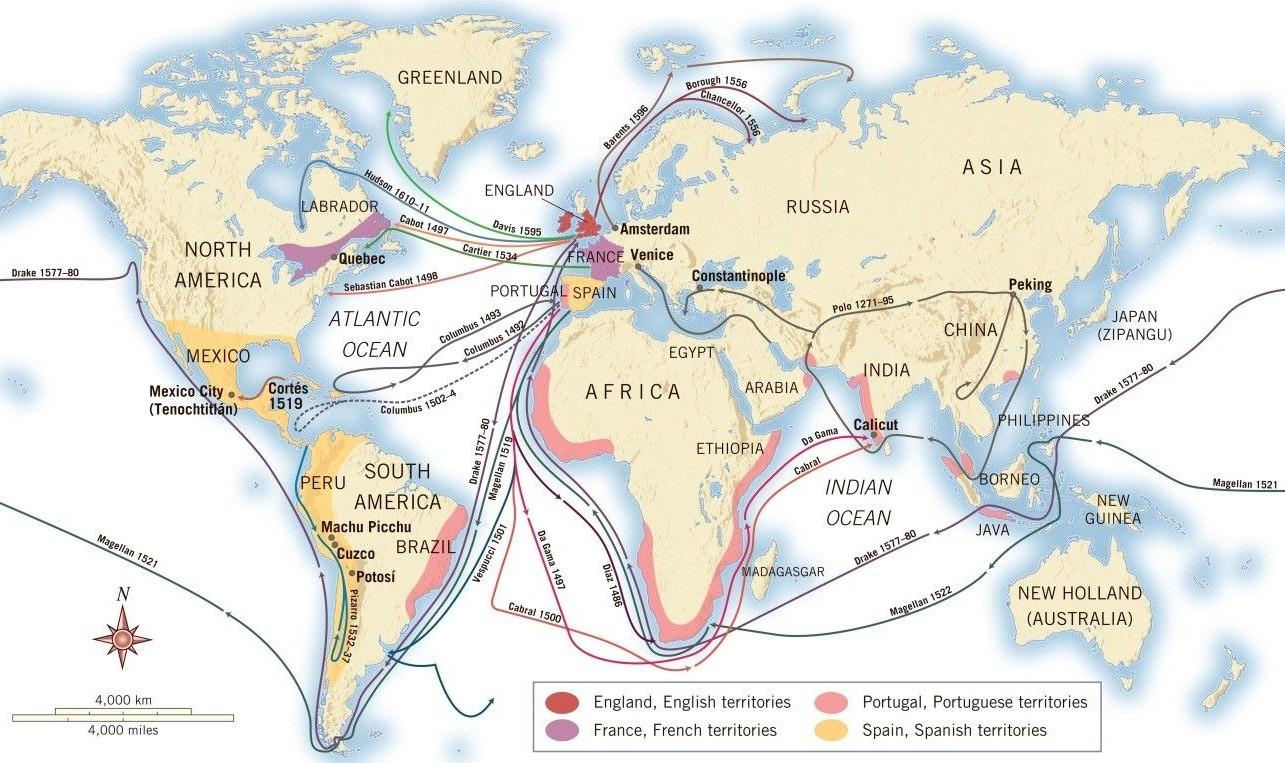India had been marginally in touch with Europe for several thousand years. Throughout the Middle Ages the Arabs had served as a link in trade, and in the sixteenth century a direct link was forged between the West and India, never to be loosened.
When the Portuguese reached India, Muslim invaders were consolidating their rule. The Muslim empire was misleadingly called Mogul (Mughal or Mongol), for its rulers were Turks from central Asia. It had little hold over the regions of southern India where Europeans first established their footholds. Local Indian rulers, whether Muslim or Hindu, were ready prey to European promises of aid against the other. All the European powers found it easy not merely to win Indian princes to their side but to raise and train native armies to fight under Portuguese, French, Dutch, or British flags.
Some of the more isolated parts of India in the Deccan, or southern peninsula, were inhabited by tribes that seemed to Europeans to have stepped out of the Stone Age. Some on the northern edges were warrior tribes, much like those who had invaded Europe from the highlands of Central Asia. In the great valleys of the Indus and the Ganges and in the richer parts of the Deccan, there was a wealthy, populous society basically Hindu in culture—though when the Europeans arrived it was dominated in many areas by Muslim invaders.
Hindu society was the result of a mix between earlier native groups and invaders from the north. The early history of India, however, is still controversial, and there is no full agreement on how numerous these invaders were or just where they came from, though the invasion apparently took place between 2000 and 1200 B.C.
According to the Hindu laws of caste, men and women were by the fact of birth settled for life in a closed group that pursued a given occupation and occupied a fixed social position. There were over a thousand castes, plus a group at the bottom without caste, the “untouchables.” The ruling groups were of two main castes, the Brahmins, or priests, and the Kshatriya, or warriors. The third main caste, the Vaisya, was based largely on vocation or trade. In theory, marriage between members of different castes was forbidden, as was change of caste through social mobility.
The priestly caste, the Brahmins, enjoyed exceptional prestige and authority. The Brahmin faith had strains of an otherworldly belief, shunning the evils of the life of the flesh and seeking salvation through mystic and ascetic denial. With this went a doctrine of the transmigration of souls, in which a sinful life led to reincarnation as lower animal life, and a virtuous life led, at least in some forms of Hindu belief, to ultimate freedom from flesh of any sort and reunion with the All-perfect.
Official Brahminism acquired a series of rigid and complicated rituals, but the religion of the common people carried over from earlier times an elaborate polytheism— gods and goddesses who were fleshly indeed by post- Greek European standards. Against all this worldliness there had arisen in the sixth century B.C. a great religious leader, Gautama Buddha. Buddhism accepts the basic Brahmin concept of the evil of this world of the flesh, but it finds salvation—the nirvana of peaceful release from the chain of earthly birth and rebirth—in a life that is ascetic but not withdrawn, a life of charity and good works.
Although Buddhism died out in India, it spread with great power to China, Japan, and southeastern Asia. In these lands it took two forms that still exist. In Tibet, China, and Japan, the Mahayana (Great Vehicle) continued to emphasize Buddha’s strong ethical desire to make nirvana available to all. In southeastern Asia and Ceylon (present-day Sri Lanka), the Hinayana (Lesser Vehicle) prevailed; in theory, the Hinayana relies more on ritual, and its monks are wholly detached from the world.
The religious thought of India has left a firmer imprint of other worldliness, of a revulsion from the struggle for wealth and from the satisfaction of human appetites, than has Christianity or Islam. In practice, Indian life displayed its measure of violence, greed, cruelty, and self-indulgence. To some observers, the educated classes of India seemed to take refuge in otherworldly doctrines as a psychological defense against the growing technological superiority of the West.

